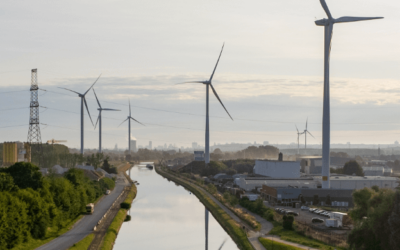Anyone with even the slightest interest in our climate will at least have some doubts about the outcome of the Glasgow conference. The fact that we have not yet got beyond weighing every word in the final text on a scale to the accuracy of a single grain of sand (are we concerned or are we seriously concerned?) does not inspire much confidence in the future. For, what is the word ‘seriously’ worth, in terms of concrete action or financial incentive to take action? We therefore believe that the real change must come from society itself. Or, more specifically, from the business community.
A typical example of what transpired in Glasgow
After two weeks of high tension-meetings, in the final declaration the world leaders come up with statements such as: “(The Conference Of the Parties) notes with serious concern the findings from the contribution of Working Group I to the Intergovernmental Panel on Climate Change Sixth Assessment Report, including that climate and weather extremes and their adverse impacts on people and nature will continue to increase with every additional increment of rising temperatures”. The fact that, since the Paris agreements in 2015, we have not progressed beyond such bloodless declarations underlines the fact that any real change has to come from society itself. With the business community at the forefront.
What about finance and innovation?
Fortunately, all over the world, there are countless examples of large and small initiatives in which businesses take the lead. In our own practice, every day we come across excellent examples of innovations that could make a difference. To inspire others, we will mention a few later on in this article. And, again, we must not wait until all policy makers fully agree on everything. Because when it comes to funding, the Glasgow Climate Pact states: “(The Conference…) emphasizes the need to mobilize climate finance from all sources to reach the level needed to achieve the goals of the Paris Agreement, including significantly increasing support for developing country Parties, beyond USD 100 billion per year”. And as far as innovation is concerned, the Conference states that it “emphasizes the importance of strengthening cooperative action on technology development and transfer for the implementation of mitigation and adaptation action, including accelerating, encouraging and enabling innovation, and the importance of predictable, sustainable and adequate funding from diverse sources for the Technology Mechanism”. Thus, more work to be done on that side!
Accelerate green innovation
The aforementioned statement refers to “including accelerating, encouraging and enabling innovation” and “the importance of predictable, sustainable and adequate funding from diverse sources for the Technology Mechanism.“ In our opinion, innovation and funding are always a good basis for concrete actions and initiatives from the business community itself. And so, our appeal to you is: join us in our mission to ‘accelerate green innovation’ and let’s make some real change by working together, as a business community. If you consider action, but still have doubts how to take it, then keep in mind that there are many groundbreaking projects where cooperation partners are sought. And also, that there are many forms of funding that can be used to realize promising ideas.
Speaking of accelerating of innovation, hydrogen is currently considered to be one of the more powerful accelerators of the energy transition. To inspire you, here are some examples of innovative projects in the field of hydrogen, and some forms of financing that can accelerate green innovation.
Hydrogen projects
Hydrogen is under development to contribute to the energy transition as a new energy carrier. Here are some inspiring examples of projects we are working on right now:
- Green Hydrogen Conversion Oosterwolde: a pilot plant capable of converting electricity into green hydrogen, as an alternative for areas where the capacity of the electric grid is not sufficient to generate large-scale solar energy
- North Sea Wind Power Hub, linking together the energy systems of North-West Europe in one coordinated network which harnesses large amounts of offshore wind. Being able to integrate different energy sectors and energy carriers, this project will be followed with great interest
- H-vision: brings together the full hydrogen value chain, to deliver up to 2,7 Mton of CO₂ emissions reductions for industry in Rotterdam by 2032
- Hydrogen in Neighborhoods Buildings: a pilot in the Dutch municipality of Lochem, in which homes with a natural gas connection are transferred to hydrogen.
Public funding
Obviously, adequate funding is essential to facilitate every climate action. Here are some examples of sources of accessible funding:
- DEI+ : a subsidy for companies which reduce the energy used in their production processes by means of an innovative technique, pilots and demonstration projects
- LIFE: large climate and environment grant programme for companies, public organisations and NGOs
- Innovation Fund: one of the world’s largest funding programmes for the demonstration of innovative low-carbon technologies. The EU Emissions Trading System (EU ETS) is providing the revenues for the Fund by auctioning emission allowances
- Horizon Europe, Cluster 5: EU innovation grants, available to speed up green and digital transitions and associated transformations of the economy, industry and society
- CEF: supports projects that focus on the development and construction of new and modernised infrastructures in the transport, telecom, and energy sectors.
Various studies have shown that the current financial instruments for scaling up and implementing new technologies can be designed even better for the industry’s climate challenge. The Dutch government is therefore working on a National Investment Scheme for Industrial Climate Projects (NIKI) to better support these industrial techniques from the transition plans. The envisaged instrument can be regarded as a national variant of the EU Innovation Fund.
In conclusion
In spite of the cautious wording in the Glasgow texts, we are not gloomy. On the contrary: just look at the Innovation Fund project list to see how many great initiatives are being developed. However, this also supports our conclusion that we should not wait for the decision-makers but simply take action ourselves. We are ready for it. Are you?


